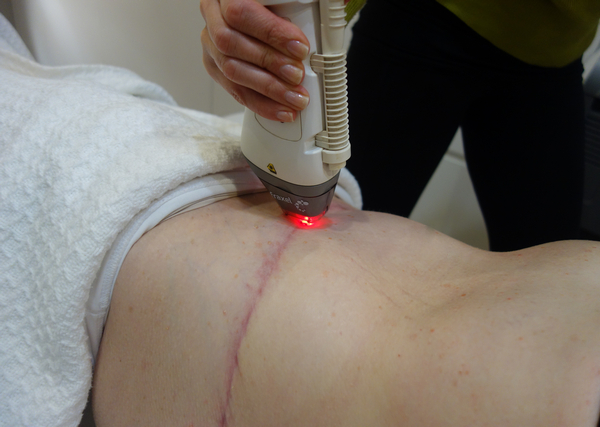7 things to know about Fraxel Laser Treatment
Fraxel laser treatments are very effective for treating a number of skin conditions including hyperpigmentation (discolouration), wrinkles and uneven skin texture.
1. What is Fraxel laser treatment?
Fraxel laser treatment is a light-based laser treatment that is used to smooth out fine lines in the skin. ‘Fraxel’ TM is a trademarked name for laser skin resurfacing device. The technical term that describes the process is ‘fractional technology’. The treatment involves making tiny injuries to the dermal tissues (skin) – called ‘imprints’. These are very minute in size, being about one-tenth of the diameter of a hair shaft. The laser produces thousands of microscopic treatment zones (MTZ’s) that penetrate deep into the dermis. The skin surrounding the pinpoint MTZ’s remains intact and unaffected.
- Fraxel is highly effective as a scar minimisation technique for post-operation scar reduction.
- Fraxel treatments by a skilled Clinician can also be used to reduce unwanted pigmentation
- examples: brown spots, sun spots, ageing spots and other areas of hyperpigmentation
- it can also help minimise other skin imperfections
- Fraxel laser treatments can also help reduce the visibility of pore sizes and improve your overall skin tone.
2. When is a Fraxel laser treatment recommended?
- It is frequently recommended by Surgeons to minimise scarring for certain procedures with long incisions (such as Tummy Tuck scars or Arm Lift – Brachioplasty scars, for example).
- So long as the patient is a suitable candidate to receive Fraxel treatments this treatment may be helpful.
- There may be a period of waiting before FRAXEL beings (a few weeks to several months after surgery) and multiple sessions or treatments are required for best results.
- The treatment is typically well-tolerated but is sometimes uncomfortable and the area can look red, raised, swollen or ‘angry’ in appearance for a few hours to a few days after treatment; but ultimately the skin is smoother and the scar looks flatter over time.

3. What are the benefits of getting a Fraxel treatment?
Cellular renewal (rejuvenation), smoothing of the skin’s surface and resolving hyperpigmentation and sun-damaged skin are some of the key benefits of Fraxel treatments.
With Fraxel(TM) laser treatments, a Dermal Clinician or Cosmetic Doctor can:
- Rejuvenate skin so it looks fresher, healthier and younger – less dull!
- Reduce fine lines, wrinkles and other skin imperfections
- Even out pigmentation issues caused by sun damage
- Treat mild acne scarring to minimise the appearance of these skin indentations or ‘acne pit’ scars
- Prevent excess scar tissue from forming when used as a post-op scar minimisation treatment (as shown below – with one of our Dermal Clinicians treating a patient who had a Tummy Tuck procedure).
4. How does Fraxel get good results?
As with other parts of the body, if the Fraxel skin ‘imprints’ is controlled, the damaged cells immediately start to regenerate.
- The skin repairs itself by pushing out the older, controlled-damaged skin and replacing it with new skin.
- As you recover from treatment, you’ll be very red, warm and likely swollen (for several days to a few weeks).
- During this time, It’s important to avoid:
- active skincare products (ask your Dermal clinician for advice)
- sun exposure (direct and indirect exposure to UV/UVA rays)
- touching your face
- using unfresh linens or washers (use fresh clean pillowcases every day after treatment, swap them daily)
- getting skin infections or breakouts
- The laser treatment triggers the body’s natural healing processes, which helps to accelerate the production of collagen and of new, healthy skin cells.
- The result for you, the patient, is healthier, younger-looking skin after the healing process has passed.

5. How many Fraxel treatments are needed – and what does Fraxel cost?
Fraxel Treatment costs in Melbourne
It’s often insufficient to have just one Fraxel treatment, although this really depends on the patient and their skincare goals.
- Generally, from 3 to 5 treatments are recommended.
- For post-surgical scar minimisation, three treatments are usually recommended.
- Each full face Fraxel costs around $1100 but there are sometimes Fraxel packages available.
- This is because it’s estimated that each treatment replaces about 15-20% of the sun-damaged, scarred or wrinkled skin.
- The time between treatments can vary depending on your reaction to the treatment but is usually between 3 and 8 weeks.
- Ask a Dermal Clinician for pricing or cost information – and be sure to ask about our Healite II Facial option to maximise your benefits!
- Download a Facial Rejuvenation Cosmetic Procedure Guide.
6. Who does Fraxel suit best – and is Fraxel good for Acne Scarring?
- If you have sun damage, discolouration, or fine to severe lines and wrinkles, this may be a good treatment for you.
- Fraxel laser treatments may also help with acne scarring for people with mild or moderate acne scarring.
- If you are pregnant or breastfeeding, you should delay having this treatment and avoid lasers.
- Younger patients may get better outcomes than individuals with long-established acne scars (e.g., under 50 is usually best).

7. What do you need to do before your Fraxel treatment?
- SKIN: Your skin needs to be in the best condition possible before a treatment
- STOP OTHER TREATMENTS: You will need to stop waxing and laser hair removal on the area to be treated, as well as avoid sun exposure for several weeks PRIOR to your Fraxel (ask your Dermal Clinician for specific pre-Fraxel instructions)
- AVOID ACTIVE PRODUCTS: You’ll also need to STOP using active products for a few weeks before your Fraxel treatment (e.g., avoid the use of all Retinols or abrasive scrubs for the designated time as specified by your Practitioner and Dermal Clinician)
- HAVE ICE PACKS ON HAND: Make certain that you have ice packs (frozen vegetable packs may suffice), as well as a very gentle cleanser for the recovery period – only use on the advice or your Fraxel clinician
- NUTRITION & AVOIDING CAFFEINE: Eating a healthy meal about an hour or two before Fraxel treatments are recommended, as this will sustain your body.
- NO CAFFEINE: caffeine is a no-no for at least 4 hours before you have a laser treatment such as Fraxel.
What does the actual Fraxel treatment involve?
- You need to be on time for your appointment as a numbing cream will be administered to the area being treated (the cream takes time to take effect)
- If you wear make-up this will need to be removed, so it’s often best to come au naturel
- Dress for comfort
- Once your skin has been numbed for about an hour, the residual numbing cream will be removed
- Gel may or might not be applied, and depends on the treatment
- One hour: The actual treatment may take up to an hour if the full face is being treated, but much less for only a specific area
- Shorter TREATMENT time frames: Treatment time for post-op scars in one area of the body, for example, may take less than 10 to 15 minutes (excluding the one hour of numbing cream time)
- Discomfort or pain sensations: Each person experiences the sensation of Fraxel differently. There is typically going to be some discomfort during a Fraxel laser treatment, and our Clinicians have some ways to manage it for you, including cold air being pumped onto the skin during treatment, to cool it. Some say it’s little more than a ‘pins and needles sensation and others say it’s painful – avoiding caffeine and following your Clinician’s advice before and after your Fraxel treatments can help reduce any related discomfort.
Aftercare for Fraxel Laser treatments: What to do after a Fraxel Treatment
- The best way to describe how your skin is likely to feel after your Fraxel treatment is as though you’ve been sunburned.
- For those who’ve made the mistake of exposing their skin to the sun for too long, you’ll know that feeling of seeing your skin get progressively redder, and knowing there’s no turning back given the amount of sun exposure.
- Skin after having Fraxel looks similar to sunburn in many ways. TIP: Just as you would with sunburn, you should use ice to reduce the heat in your skin (don’t directly ice the skin, ask your Clinician for the best application methods).
- You should do this for about 5 or 10 minutes for the first 6 hours after treatment.
- Again, just like sunburn, the redness in your skin will fade after about 3 days but could take longer.
- Most people can then cover residual redness with makeup.
- Bruising is very rare but the swelling is likely; every patient may respond differently.
How close to an important event can I get a Fraxel treatment?
Many people want their skin to look its best at an important function – such as a Wedding, a Graduation Ceremony, or a Photography or Videography session (even for a Job Interview).
- You CAN sometimes cover up the initial post-treatment redness with the right mineral makeup (ask our Dermal Clinicians for advice including how long you’ll need to wait before applying mineral makeup such as Jane Iredale mineral cover).
- BUT if you have an important function or event to attend, then you should schedule a treatment at LEAST 3 weeks beforehand or maybe longer.
- That way, you’re sure to look glowing – with “little-to-none” residual evidence of having had a Fraxel treatment
- Your skin may also flake a little after treatment – this is common, but keep moisturizing the skin with the right products to help reduce the appearance of dry flaky skin. This may go on for longer than 3 weeks but often resolves within 4 weeks (plus or minus a few weeks).
- If your skin itches, DO AVOID scratching and avoid touching your face.
- Clean your hands regularly and use fresh pillowcases and fresh face washers every day if possible.
The most important aspect of post-op Fraxel care is to avoid ALL sun exposure. You’ll find it a challenge to avoid the sun as even driving to work exposes the skin to far more sun than you realise, but it’s highly important for your results that you protect your newly-treated skin from the SUN and for the right length of time.
Exercise and Sauna Exposure after a Fraxel Laser Treatment – Guidelines
- Exercise and Sweating after laser: You should NOT exercise or swim for at least a week and also shouldn’t sweat (if possible)
- Due to the no-sweating rule, you should also avoid saunas and hot tubs until your skin is completely healed from the treatment
- For about 3 days after treatment, if you’re showering, avoid a direct spray of hot water on the treated area(s)
- It’s also a good idea to stay away from consuming alcohol for at least 2 to 3 days and to keep your head raised on extra pillows when you sleep for at least 2 nights.
- Follow these recommendations and your Clinician’s post-Fraxel guidelines – some of these recommendations are best off followed for several weeks and you may have special instructions relating to your own treatment and your skin’s health and recovery needs
- If any questions, ASK – it’s very important that you know how to care for your post-Fraxel skin during the rejuvenation period for BEST results.

Fraxel treatment results: fresher looking skin with fewer lines and wrinkles
The improvements will depend on the treatment you decide on (there are several potential levels or protocols you MIGHT be eligible for). But even the milder Fraxel treatments should produce between a 20 and 40% improvement in lines and wrinkles.
If you go for the more aggressive laser treatments, this means more downtime, but the results might be increased to as high as a 70% visible improvement.
Recovery takes time before you see the final results of Fraxel; with multiple treatments often helpful to get the best skin rejuvenation value:
If you remember that your skin is renewing itself and that collagen remodelling has taken place in the DEEPER layers of the skin, you’ll realize that your results will become clearer over time…because even though you see the Fraxel treatment on the outer skin layer, it actually increases the cellular renewal below the skin’s visible surface (which then eventually shows up as the skin renews itself).
Helpful Tip: For the first few days after Fraxel, you may feel you look worse. But after approximately one week, you’ll start to see an improvement that should continue over the next few months.
“Most people talk about achieving a ‘glow’, which sounds healthy and youthful!”
How long the effects of the treatment will last will depend on how well you protect your skin from the sun, as well as on your genes and healing protocols; as genes and environmental factors intertwine to determine the ageing process as well as your healing and skin rejuvenation processes.
Fraxel doesn’t stop ageing, but it slows it down by helping combat some of your earlier sun damage and encouraging cellular renewal at the deeper layers of your skin – layers that products just can’t get to.
Download our free guides or phone us today – and ask for a no-obligation consultation.
The post Fraxel: 7 Things to Know About Fraxel Laser Treatment appeared first on Coco Ruby Skin.
--------------------------------------------------------------
By: Coco Ruby Team
Title: Fraxel: 7 Things to Know About Fraxel Laser Treatment
Sourced From: cocorubyskin.com.au/blogs/fraxel-7-things-to-know-about-fraxel-laser-treatment/
Published Date: Mon, 08 Mar 2021 07:31:48 +0000
Did you miss our previous article...
https://biohackersnews.com/anti-aging/vitamin-d-faqs
.png)





